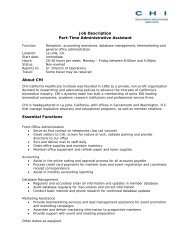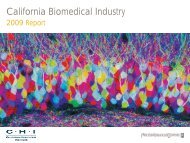2011 <strong>California</strong> <strong>Biomedical</strong> <strong>Industry</strong> ReportConclusionAs demonstrated by the metrics, features and findings presented in this report, <strong>California</strong>’s biomedical industry plays asignificant and crucial role in the state.It represents the vanguard of innovation. <strong>California</strong> leads the country as well as the world in innovative therapeuticcompounds and technologies. The state’s institutions continue to pioneer ways to improve public health. Firms in the stateare devising, improving and introducing new therapies, therapeutics, devices, tools and diagnostics everyday to address thechanging and often critical needs of patients everywhere. The first biotechnology company was founded and continues tothrive in <strong>California</strong>. Today, our industry is in the forefront of emerging fields, such as personalized medicine, nanotechnologyand stem cell research.The cutting edge research and development work in <strong>California</strong> continues to attract substantial amounts of governmentgrants and venture capital funding. Although both sources reached a plateau — remaining essentially flat through 2009 ascompared to 2008 — there are some hints that venture capital is returning to the biomedical industry. A handful of initialpublic offerings (IPOs) were undertaken in 2010, and the industry saw an increased number of acquisitions as well. As thesetransactions show financial benefit, other investors are poised to again step forward.Life sciences organizations depend on an educated workforce drawn from a wide range of disciplines and functions. Theseprofessionals require specialized training and expertise, attributes that many are able to strengthen through employersupportedcontinuing education. The state’s companies and educational bodies have stepped up to ensure that workforcedevelopment is available and robust at the state’s community and four-year colleges and universities. Moreover, educatorsand employers alike are reaching out to engage school aged children in math and science and to guide the next generation of<strong>California</strong> innovators toward careers in engineering, science, technology and medicine.In the current climate, perhaps the industry’s most critical contribution is to the economy. The state’s academic andindependent research institutions and its biopharmaceutical, diagnostics, medical device and wholesale trade companiesemploy hundreds of thousands of <strong>California</strong>ns directly — and sustain the businesses and augment the incomes of countlessothers. Its jobs are typically well-compensated and fulfilling. The tax contributions to the state’s operations are significantand multiply through the income, property and sales taxes paid by individual employees. In comparison to <strong>California</strong>’s otherflagship industries — aerospace, IT and motion pictures, for instance — the biomedical industry has proven more resilient. Itretained the largest percentage of jobs among the group in the recent economic downturn.Because the biomedical industry in <strong>California</strong> contributes so much to the economy and public health, policymakers havea clear interest in continuing to support the life sciences. <strong>Industry</strong> leaders from the 2011 CEO Survey have pointed toopportunities to make our business environment more friendly and what this means in terms of tax policy, regulation,technology transfer, environmental regulation and tort reform. All this and more will be the subject of vibrant discussionbetween industry and policymakers. Clearly, <strong>California</strong> will benefit from an expansion of life sciences research anddevelopment and manufacturing and stability at all levels of the state’s education system.<strong>California</strong> and its residents have worked very hard for decades to build the most innovative and productive biomedicalindustry in the world. That industry has introduced and continues to pursue new therapies and approaches to improvingpatient outcomes, public health and quality of life the world over. It also continues to give back to the state. It is a componentof the state’s economy and, indeed, its legacy that keeps on giving. At this critical juncture, let us commit to ensuring that italways will.David Gollaher, Ph.D. Gail Maderis Tracy LefteroffPresident and CEO, President and CEO Partner, National Life SciencesCHI-<strong>California</strong> <strong>Healthcare</strong> <strong>Institute</strong> BayBio PricewaterhouseCoopers LLP100 | <strong>California</strong> <strong>Biomedical</strong> <strong>Industry</strong> 2011 Report
MethodologyEmployment, Wages, and<strong>Industry</strong> ImpactsDataThe data used to estimate employmentand wages in <strong>California</strong>’s biomedicalindustry are made available by theBureau of Labor Statistics (BLS)Quarterly Census of Employment andWages (QCEW), available at http://www.bls.gov/cew/. The 2009 datareflected in this report were collectedin the fall of 2010. Data for prior yearsmatch the statistics reported in the<strong>California</strong> <strong>Biomedical</strong> <strong>Industry</strong> 2010Report in order to ensure comparabilitybetween reports.The QCEW is a near comprehensivecensus of employment and wageinformation at the national, state, andcounty levels for workers covered bystate unemployment insurance lawsand federal workers covered by theUnemployment Compensation forFederal Employees program. It doesnot include the self-employed, unpaidfamily workers, or private householdemployees. Jobs are counted regardlessof full-time or part-time status.Individuals who hold more than onejob may be counted more than once. Inorder to protect the confidentiality offirms’ information, the Bureau of LaborStatistics does not disclose data thatwould be easily identifiable to individualparticipating companies. Given thesmaller number of establishments thatcan occur at the county level, countyleveltotals may not represent the fullnumber of employment positions andwages for each industry. These positionswould be included by the BLS inaggregated state-level data.For reports prior to 2009, a reviewof employment data from companyspecificSecurities and ExchangeCommission (SEC) filings was alsoused to estimate employment in thebiomedical industry, specifically forthe medical device, instruments, anddiagnostics sector. The results of thereview were carried forward in thisyear’s report. Company filings with theSEC can be obtained from the EDGARdatabase available at http://www.sec.gov/edgar/ searchedgar/webusers.htm.The sectors of the biomedical industrythat are used in this analysis arecomprised of several North American<strong>Industry</strong> Classification System (NAICS)codes. For the QCEW, companies areassigned a single NAICS code by stateworkforce agencies, and thereforea company that manufactures bothpharmaceuticals and medical deviceswould only be classified in one of thesesectors depending on which is theprimary production of the company ateach establishment.The table, on the following page,displays the NAICS codes used to definethe biomedical industry in <strong>California</strong>,along with the portion of the codeattributable to the industry.MethodologyThe most recent full year for which wageand employment data were availablefor the publication of this report was2009. QCEW employment and wagedata are identified for selected NAICScodes used to define the biomedicalindustry. The relevant NAICS code dataare then multiplied by the percent of thebiomedical industry that is representedin the NAICS code, as derived by PwCfrom Census Bureau data (see table onpage 103). This methodology is identicalto the process used in the <strong>California</strong><strong>Biomedical</strong> <strong>Industry</strong> 2009 and 2010reports, so the results in all reportsare directly comparable. Prior to the<strong>Biomedical</strong> <strong>Industry</strong> 2009 report, PwCestimated narrow industry categoriesbased on broader industry statistics,such as employment data from the<strong>California</strong> Employment DevelopmentDepartment at the three- and four-digitNAICS code level, that were availablein the most recent year. The currentQCEW-based methodology provides amore accurate portrait of <strong>California</strong>’sbiomedical industry but makes thisreport and the 2009 and 2010 reportsincomparable to earlier publications.There was an anomaly in the QCEWwage data for the biopharmaceuticalsector in the first quarter of 2009,with wages per biopharmaceuticalemployee being over twice the amountin the first quarter as in the remainingquarters. According to the BLS, swingsin wages can occur due to mergers andacquisitions, bonuses, or other payouts.For example, if an employee is givena bonus of 12 months pay in January,her January wages are recorded as hersalary plus the full bonus. To correct forthe anomaly, we replaced the reportedfirst quarter wage data with the averagewage across the second, third, andfourth quarters weighted by averagequarterly employment. This adjustmentwas only done to the reportedbiopharmaceutical wages at the statelevel, as the anomaly was not evidentfor wages in the clusters.Employment data from the QCEWwere also used in conjunction with theIMPLAN economic model for the stateof <strong>California</strong> to quantify biomedicalindustry revenues and the direct,indirect, and induced impacts of theindustry in <strong>California</strong>. IMPLAN is awell known modeling system developedby the Minnesota IMPLAN Group forestimating economic impacts and issimilar to the Regional Input-OutputModeling System developed by the U.S.Department of Commerce. The modelis primarily based on government datasources. It can address a wide range ofimpact topics in a given region (county,state, or the country as a whole).IMPLAN is built around an “inputoutput”table that relates the purchasesthat each industry has made from otherindustries to the value of the output ofeach industry. To meet the demand forgoods and services from an industry,purchases are made in other industriesaccording to the patterns recorded inthe input-output table. These purchasesin turn spark still more purchases bythe industry’s suppliers, and so on.<strong>California</strong> <strong>Biomedical</strong> <strong>Industry</strong> 2011 Report | 101






